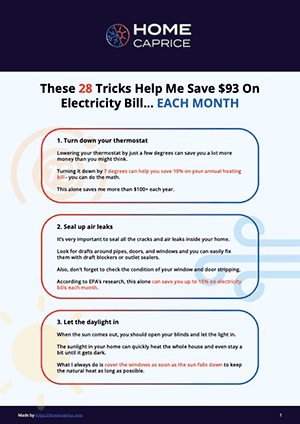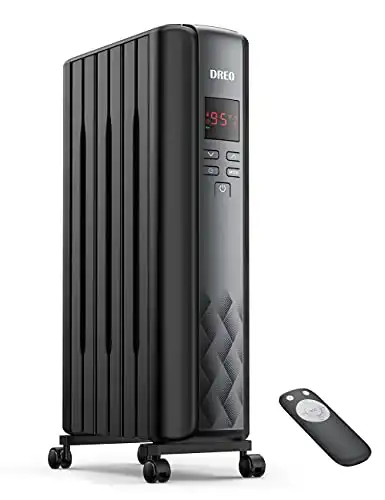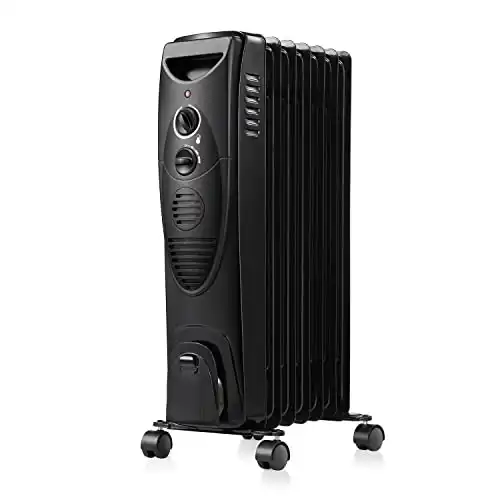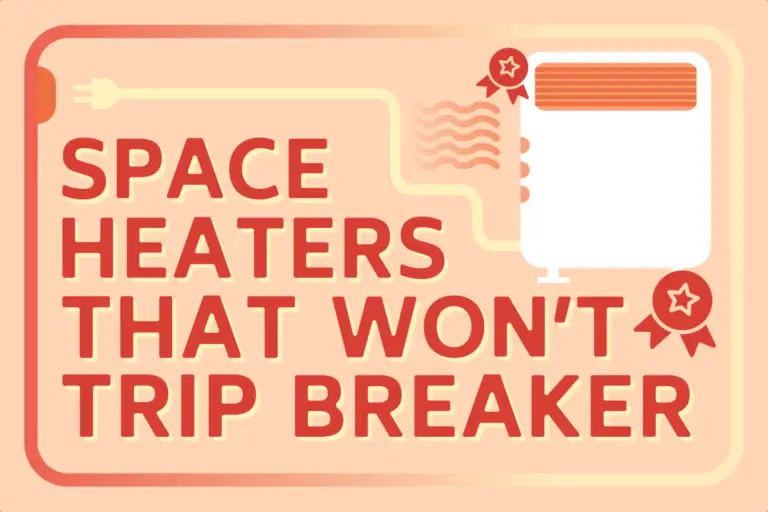Are oil-filled radiator heaters dangerous or not?
It’s a common question many ask along with similar safety-related questions about these kinds of heaters.
In this article, I try to answer these safety questions for you, along with other safety-related questions and tips in this complete guide to Oil-Filled Heater Safety.
Let’s get into it!
Oil-Filled Heater Safety
Safety is always paramount. Especially if you have kids or pets around your home.
While oil heaters are a fantastic way to heat your home, there are some things to be aware of when using them. One of the first places to start in regard to oil-filled heater safety is the independent safety tests the particular unit has passed.
How do you know if it has passed any?
Look for the following certifications (depending on your country) or ask the seller which ones the heater has passed/undergone.
If the unit has certification from some or all of these safety tests then you can consider your heater ahead of the pack when it comes to safety.
What do these places do?
Effectively they are companies and organizations that certify, validate, test verify, inspect, and audit products. If these products pass then they are given certification from that agency.
It helps customers feel safer knowing the products have been safety tested.
Think about it like this
Wouldn’t you like to know the product you are bringing into your home, which has inherent risks, has been rigorously tried and tested before you start using it? Imagine getting a product off the shelf with no testing and being the crash test dummy.
No thanks.
So be sure to look out for these marks of certification before you buy.
How do oil-filled heaters work?
Oil-filled heaters create heat by warming oil inside sealed columns or fins. Air then passes over and around these columns which then distributes into your room, the room, heated air.
It is a great way to heat your home as it provides a quiet, gradual, and efficient way of heating. You should allow the heater to heat for up to 10-15 minutes for optimal performance.
Where to put an oil-filled heater in your room?
I think we can agree that most people want to optimize their efficiency when heating their room and hopefully save money in the process.
A good way to do this is to make sure your oil heater is in the best place in the room for optimum heating.
So where is the room in that?
Well, according to the manufacturers, the best place to place your oil-filled heater is beneath the coldest window in your room, or where there might be a cold draft.
Having the heater there will reduce the effects of the cold draft helping warm your room, and also reduce the cooling effect of the draft. For safety reasons, your heater should not be placed immediately below a power outlet.
Can oil-filled heaters be used as the main heating system?
Unless you have a very small house you are not likely to heat your whole house with an oil-filled heater. They are generally made for small to large rooms, not entire homes.
If you usually spend time in a couple of rooms, such as a living room and bedroom, you could certainly cut out the use of other heating appliances. This is what we do for our bedroom at home and it works well for us.
We are also lucky that we have a very well-insulated house with double-glazed windows which retains the heat well. Having a well-insulated house is critical in retaining heat and keeping those energy bills low.
How do you set the thermostat on oil-filled heaters?
Before we get to what temperature is ideal for setting your thermostat to, it’s important to understand how the thermostat works. It is a point of confusion, but the thermostat on the oil heater works to the temperature of the room and not to the temperature of the heater itself.
Now.
What temperature should you set your thermostat to?
The World Health Organization’s standard for comfortable warmth is 18 °C (64 °F) for normal, healthy adults who are appropriately dressed.
For those with respiratory problems or allergies, they recommend no less than 16 °C (61 °F), and for the sick, disabled, very old, or very young, a minimum of 20 °C (68 °F).
With that said, there is always the opportunity to save a bit of money if you prefer.
How?
Bill Prindle, deputy director for the nonprofit American Council for an Energy-Efficient Economy says: “The rule of thumb is that you can save about 3% on your heating bill for every degree that you set back your thermostat full time”
It all adds up!
Safety features to look out for an on oil filled radiator heater
You want peace of mind when it comes to the dangers of oil heaters, which is why having safety certification is important. They also come with a number of safety features, so be sure to look out for these if you are thinking of purchasing.
Thermal cutoff or overheating protection
This feature ensures your heater does not get too hot by shutting off automatically when it reaches a certain temperature. This will help prevent any serious burns and also reduce the risk of fires should anything happen to be placed over the heater.
Anti-freeze setting to help prevent freezing pipes
Not so much a safety feature as it is a convenience feature, but many models come with anti-freeze to prevent the oil inside the heater from freezing. If your pipes freeze, your heater will be pretty much buggered.
Tip-over switch
A super important feature for those that have pets, or clumsy humans around the house. Should the heater be knocked over somehow, the heater will automatically turn off preventing the heater from burning through your floor into the basement! (and less dramatic, but just as problematic issues).
Covered fins
It is no secret that one of the cons of oil-filled radiator heaters is the fact the fins are exposed and it really is not that difficult for someone to get burned. Fortunately, these days you are able to find oil-filled heaters that have covered fins. This means no more exposure to warm surfaces and far more safety for small humans and animals.
I don’t know about you but I personally wouldn’t settle for a heater without at least the first 3 safety features. And to be honest, some of the covered oil heaters do look pretty slick!

Download this FREE cheat sheet to find 28 tricks that can help you save on your electricity and heating bill each month.
Click here to get a FREE Cheat-SheatWhat are the dangers of oil heaters?
Below are a few of the most common questions about the danger of oil-filled heaters:
Can oil-filled heaters explode and cause a fire hazard?
The answer is no and yes.
Let me explain.
Oil-filled heaters are not likely to explode. If everything is working as it should be with the heaters and nothing is covering the vents and there is no oil leak, then you should likely be fine.
Oil heater dangers
They can be a fire hazard. If the heater has an oil leak, then this will certainly be a hazard.
Also, if there are easily flammable or easily melted items placed on the heaters this will also be a fire hazard. It is always recommended that you never leave an oil heater unattended for these reasons. But for the most part, if you use caution, have adequate safety features, and correctly working unit, you shouldn’t have an issue.
Like anything that gets hot, you just have to be smart about things.
Fumes from the oil-filled radiator
It is a fairly common question and certainly a legitimate concern when it comes to oil-filled radiator heaters.
- Are there any fumes?
- Do they release carbon monoxide?
Well, good news.
There are no fumes and the heaters do not produce carbon monoxide. Why?
The oil inside the heater is never burned therefore no gasses are released. It is only heated inside a fully enclosed frame.
If you have a heater that is burning fuel of some sort, then you will need to be concerned and ensure there is adequate ventilation.
Are oil heaters safe to leave on overnight?
Most manufacturers of oil heaters state that it is not safe to leave an oil heater on overnight unattended. Now does that mean you can’t leave it on overnight?
It depends who you talk to 🙂
Manufacturers such as Lasko recommend to never leave your heater (of any kind) on overnight. But, and I’ll have to say, I’m guilty of this too, many do leave their heaters on overnight.
There are pros & cons in doing this:
- Leaving your oil filled heater on overnight can cause dry skin and dry throats which are highly uncomfortable. The good thing about heaters, oil-filled or otherwise these days, is they have many features available which make using a heater at night.
- Features such as timers – for turning a heater off late at night, and on early in the morning. This is actually what we do, so we are warm when we go to sleep and it is not cold when we get up.
- Usually, we would retain enough heat so as to not get cold in the space in between. Colder climates, however, have the additional option of using the in-built thermostat. This way the heater can turn on and off as per the temperature of the room, in which case it would not be on all night.
- There are a number of heaters that allow you to program in certain temperatures for certain times in the night (and day) to enable more safety as well as an energy-saving routine. There are even oil filled smart heaters of which you can control on your smartphone.
Other safety tips for oil-filled radiator heaters:
- Always remember that oil-filled heaters are not intended for use in bathrooms, laundry or any areas where there could be any form of contact with water. Water and oil-filled heaters do not mix!
- Manufacturers always recommend to not run the cords of an oil heater under any carpet, rugs, runners, or anything that will cover the cord.
- In order to prevent fires always make sure any air intakes are not covered or on soft surfaces or places where an opening may become blocked.
- Manufacturers also recommend to never plug an oil-filled heater into an extension cord or relocatable power strip. (Oops!)
- They should always be plugged in directly into the power socket.
A few other things to note in regard to oil-filled heaters:
- Oil-filled heaters contain oil that is permanently sealed and will never require refilling or replacing
- As the heater warms up, the oil in the metal columns may naturally expand and make a slight ticking sound. This is normal and will stop once the oil has reached the optimal temperature.
I hope this article helped answer some of your safety concerns in regard to oil-filled heaters.
Not sure which kind of heater is right for you?
Check out our guides on ‘Oil Heaters vs Ceramic Heaters‘, ‘Oil Heaters vs Electric Heaters‘ and find the Best Oil Filled Heater, Oil Filled Heater FAQs


Download this FREE cheat sheet to find 28 tricks that can help you save on your electricity and heating bill each month.
Click here to get a FREE Cheat-Sheat

![6 Best Smart Space Heaters [with Wi-Fi]](https://homecaprice.com/wp-content/uploads/2021/07/6-Best-Smart-Space-Heaters-with-Wi-Fi-768x512.jpg)


